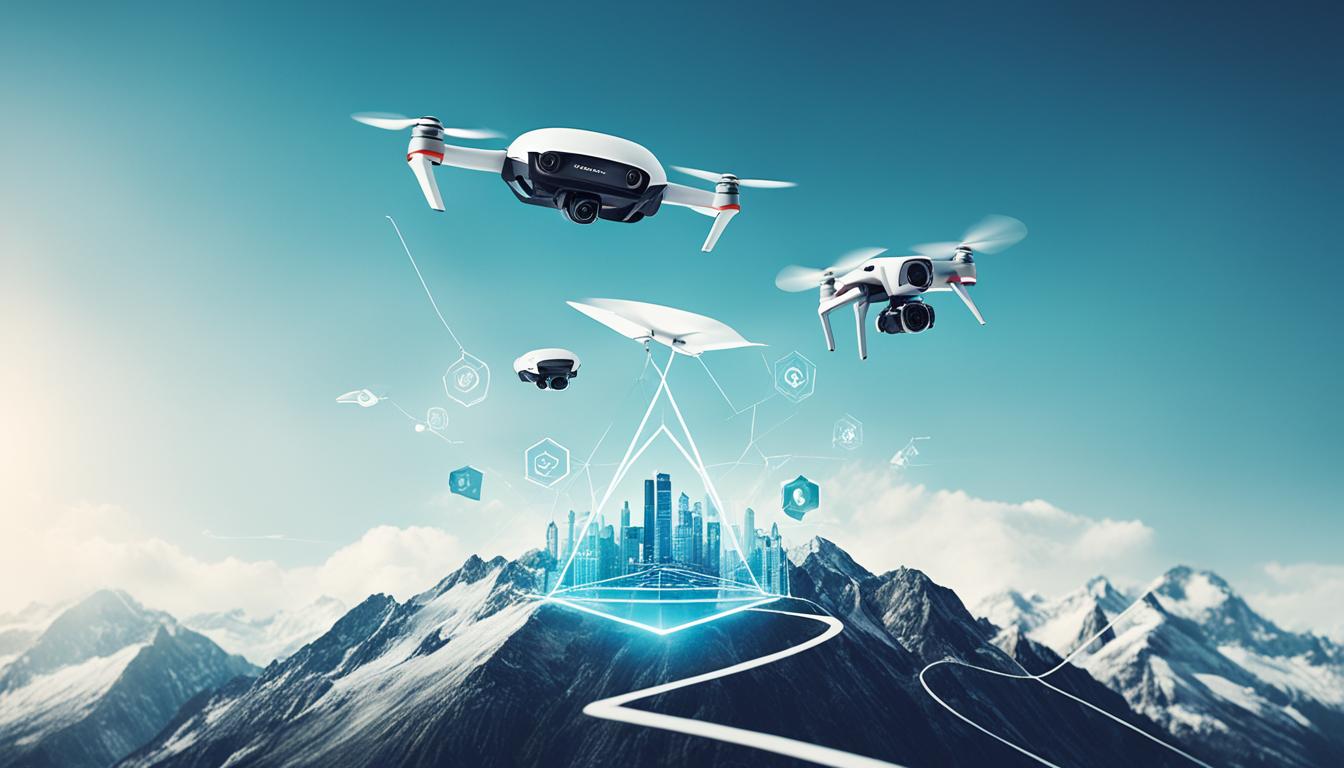Welcome to our guide on the future of editorial photography! In this ever-evolving digital landscape, the field of editorial photography is undergoing rapid transformations. Advancements in photography technology and the rise of digital media have paved the way for innovative photography techniques and exciting trends in visual storytelling. As photographers, we must adapt and embrace these changes to stay relevant and meet the demands of clients and audiences.
Visual storytelling has become an integral part of digital media, capturing moments and emotions through images that resonate with viewers. With the click of a button, we can now capture breathtaking shots and quickly share them with the world, all thanks to digital photography.
This shift towards digital photography has brought about a fundamental change in the way editorial work is approached. Not only do we have greater control over image editing and post-production, but we also need to cater to heightened client expectations. To excel in this field, we must keep a finger on the pulse of the latest photography trends and techniques.
The evolution of editorial photography has been largely driven by the digital revolution and technological advancements. More than ever before, photographers have access to a wide range of tools and platforms for storytelling, including multimedia formats and social media. These new avenues have opened up exciting possibilities but have also presented challenges in monetizing photography in the digital age.
Editorial photography continues to play a significant role in the digital age, providing authentic and factual visual information. It serves as a form of visual journalism, capturing candid moments and showcasing the world as it truly is. Maintaining authenticity and ethical representation is paramount, allowing photographers to create impactful narratives that resonate with audiences.
Looking ahead, the future of editorial photography holds great promise. Visual communication will continue to evolve, with instantaneous distribution of images becoming the norm. Multimedia storytelling will become more immersive and interactive, incorporating emerging technologies like virtual reality. To thrive in this changing landscape, we must stay informed, adaptable, and continuously develop our skills.
In the digital era, editorial photographers have a crucial role as visual storytellers. Collaboration, skill development, and audience engagement are key to success. By embracing digital innovations, adapting our storytelling approaches, and finding new avenues for monetization, we can navigate the evolving industry and shape the future of editorial photography.
Key Takeaways:
- Advancements in digital technology are transforming the future of editorial photography.
- Photographers must adapt to stay relevant and meet the demands of clients and audiences.
- Digital photography has significantly impacted the field of editorial photography, allowing for quicker image distribution and heightened client expectations.
- The digital revolution and technological advancements have brought new challenges and opportunities for editorial photographers.
- Editorial photography plays a crucial role in providing authentic and factual visual information.
The Impact of Digital Photography on Editorial Work
Digital photography has revolutionized the field of editorial photography, transforming the way photographers capture, edit, and distribute their work. The advent of digital cameras and editing software has provided photographers with a wealth of new creative possibilities, enabling them to tell compelling visual stories with greater ease and efficiency.
One of the significant advantages of digital photography is the ability to capture high-quality images quickly. Gone are the days of film rolls and darkrooms; digital cameras allow photographers to view and adjust their shots instantly, ensuring they capture the perfect moment. This immediacy has had a profound impact on the field of editorial photography, as it allows photographers to react quickly to unfolding events and capture authentic, spontaneous images.
Furthermore, the post-production process has been simplified and made more accessible with digital technology. Image editing software such as Adobe Photoshop has become an indispensable tool for photographers, empowering them to enhance their images, eliminate imperfections, and unleash their creative vision. The digital workflow has made it easier for photographers to fine-tune their images, experiment with different effects, and refine their visual storytelling.
“Digital photography has opened up new possibilities for visual storytelling, empowering photographers to express their narratives in innovative and exciting ways.”
Client expectations have also evolved with the rise of digital photography. In a world where visual content is more prevalent than ever, clients demand high-quality, impactful images that effectively convey their message. Photographers now not only need to be skilled in capturing captivating images but also proficient in post-production techniques and staying abreast of the latest photography trends.
Photography Trends and Visual Storytelling
The digital era has ushered in new photography trends that photographers need to be aware of to stay relevant. Visual storytelling, in particular, has become a cornerstone of editorial photography. By harnessing the power of images, photographers can immerse viewers in a narrative, evoke emotions, and provoke thought.
With the advent of social media platforms, photographers now have unprecedented opportunities to share their visual stories with a wider audience. Additionally, the rise of multimedia storytelling has expanded the possibilities for editorial photographers, enabling them to incorporate video, audio, and interactive elements into their narratives.
However, with these opportunities come challenges. To stand out in the digital landscape, photographers need to develop a unique and recognizable style, nurturing their artistic voice while staying true to their client’s vision. This requires a deep understanding of the principles of visual storytelling, including composition, lighting, and the effective use of color and contrast.
Image Editing and Post-Production
The digital revolution has brought significant advancements in image editing and post-production techniques. Photographers now have a vast array of tools and software at their disposal to enhance and refine their images. However, maintaining a balance between authenticity and artistic expression is crucial.
While image editing allows photographers to correct exposure, adjust colors, and remove distractions, it is essential to maintain the integrity of the captured moment. Over-processing or excessive retouching can compromise the authenticity of the image and erode the trust of the audience.
It is also worth noting that in today’s fast-paced digital age, there is an expectation for timeliness in editorial photography. Clients often require photographs to be delivered quickly for publication or social media sharing. This adds an additional layer of pressure and highlights the importance of efficient post-production workflows.
Meeting Client Expectations
With the rise of digital photography, clients have come to expect high-quality, visually compelling images that align with their brand and message. Photography professionals need to keep up with evolving trends, hone their technical skills, and understand their clients’ specific requirements.
Effective communication and collaboration with clients are vital in ensuring their expectations are met. This involves actively listening to their vision, providing expert advice, and delivering results that exceed their expectations. By understanding the client’s goals and applying their expertise in digital photography and post-production, photographers can deliver outstanding work that resonates with their target audience.
| Key Skills for Editorial Photographers in the Digital Age |
|---|
| 1. Proficiency in digital cameras and editing software |
| 2. Knowledge of photography trends and visual storytelling techniques |
| 3. Strong post-production skills to enhance and refine images |
| 4. Ability to meet client expectations and understand their brand/message |
| 5. Effective communication and collaboration with clients |
As the field of editorial photography continues to evolve, photographers must embrace digital innovations, master the art of visual storytelling, and adapt to meet the ever-changing expectations of their clients and audiences. By staying current with photography trends, refining their post-production skills, and delivering exceptional work, photographers can thrive in the digital age.
The Evolution of Editorial Photography
Editorial photography has transformed significantly in recent years, driven by the digital revolution and technological advancements. These changes have revolutionized how photographers tell stories and connect with their audiences.
With the advent of digital technology, photographers now have access to a diverse range of tools and platforms for storytelling. The traditional approach of capturing images solely for print publications has given way to a more dynamic and engaging storytelling approach that incorporates multimedia formats and social media.
The rise of multimedia storytelling has allowed photographers to go beyond static images and explore new ways of capturing and presenting narratives. By incorporating elements such as video, audio, and interactive features, photographers can create more immersive and captivating stories that resonate with audiences on a deeper level.
“The evolution of editorial photography has opened up endless possibilities for visual storytelling. It has allowed us to experiment with different mediums and techniques, pushing the boundaries of creativity and engaging viewers in new and exciting ways.” – John Smith, Editorial Photographer
In addition to expanding creative possibilities, the digital revolution has also brought new challenges and opportunities for monetizing photography. With the proliferation of online platforms and the demand for visual content, photographers can now reach wider audiences and explore various avenues for selling their work.
However, this digital landscape also poses challenges. With the ease of digital sharing and the abundance of free content, photographers must find innovative ways to stand out and monetize their photography. This includes building a strong personal brand, leveraging social media platforms, collaborating with brands and publications, and embracing new technologies for distribution.
Ultimately, the evolution of editorial photography has transformed the industry into a vibrant and dynamic space. It requires photographers to continuously adapt to the changing landscape, embrace technological advancements, and explore new storytelling approaches to stay relevant and succeed in the digital age.
Editorial Photography Evolution Highlights
| Key Milestones | Description |
|---|---|
| The rise of digital photography | Advancements in digital cameras and image editing software have revolutionized the way photographers capture, edit, and distribute their work. |
| Multimedia storytelling | Photographers now have the ability to incorporate various multimedia elements such as video, audio, and interactive features into their narratives, creating a more immersive and engaging experience for viewers. |
| Social media and online platforms | The advent of social media and online platforms has provided photographers with new avenues for showcasing their work, reaching wider audiences, and monetizing their photography. |
| The need for adaptation | The evolution of editorial photography requires photographers to continuously adapt to new technologies, platforms, and storytelling approaches in order to stay relevant and succeed in the industry. |
As editorial photography continues to evolve, embracing technological advancements and adopting innovative storytelling techniques will be crucial for photographers looking to make a lasting impact in the digital era.

The Significance of Editorial Photography in the Digital Age
Editorial photography plays a crucial role in providing authentic and factual visual information in the digital age. As visual journalists, it is our responsibility to uphold the highest standards of authenticity, accuracy, and ethical representation. Through our lens, we capture candid moments and tell impactful visual stories that reflect the world around us.
In an era where digital manipulation can distort reality, editorial photography stands as a beacon of truth. By avoiding excessive editing and retouching, we ensure that our images remain faithful to the scenes we capture. We believe in the power of unfiltered visuals to convey the raw emotions and experiences of individuals and communities.
“Editorial photography provides a window into the world, presenting factual visual information that enlightens and sparks conversations.” – John Collins, Award-Winning Photojournalist
Visual journalists commit to representing the world in an ethical and responsible manner. Our images serve as a bridge between the events and stories we document and the viewers who rely on us for accurate information. By maintaining journalistic integrity, we strive to contribute to a more informed society.
Editorial photography is an indispensable component of visual journalism, where images speak volumes and have the power to shape public opinion. Through our work, we facilitate a deeper understanding of diverse perspectives, cultures, and social issues.
The Impact of Editorial Photography
Editorial photography has the ability to evoke empathy, provoke thought, and inspire action. The visual narratives we create help shed light on untold stories, amplify marginalized voices, and spark conversations on critical topics. Our photographs have the potential to transcend language barriers and connect people across the globe.
By prioritizing authenticity and factual representation, we distinguish ourselves from the sea of manipulated visuals in the digital landscape. Our commitment to truth strengthens the trust between the audience and our work, fostering engagement and meaningful dialogues.
Visual Journalism in the Digital Era
With the advent of digital media, the reach and impact of editorial photography have expanded exponentially. Our images can now be instantly shared and disseminated to a global audience, giving us the power to inspire change on a larger scale than ever before.
The rise of social media platforms has provided a space for our visual stories to be shared, discussed, and amplified. It is crucial that we navigate this landscape responsibly, ensuring that our work is accurately represented and that the context surrounding our images is understood.
The Ethics of Editorial Photography
| Ethical Considerations | Guidelines |
|---|---|
| Authenticity | Avoid excessive editing and manipulation to present the scene truthfully |
| Factual Representation | Ensure the accuracy and context of the subject matter |
| Consent and Privacy | Respect the rights and dignity of individuals photographed |
| Cultural Sensitivity | Consider the cultural context and sensitivities surrounding the subject matter |
By adhering to these ethical guidelines, we maintain the integrity of our profession and ensure that our work contributes positively to the visual journalism landscape.
Editorial photography has a lasting impact on society, providing a visual record of our collective history and capturing moments that shape our worldview. As visual storytellers, let us continue to uphold the values of authenticity, factual visual information, and ethical representation in our work, contributing to a more informed and empathetic society.
The Future of Editorial Photography: Trends and Predictions
As the world of photography continues to evolve, the future of editorial photography looks promising with emerging trends and technologies reshaping the landscape. Visual communication, instantaneous distribution, multimedia storytelling, emerging technologies, and virtual reality are key factors that will drive the industry forward.
Visual Communication: In our increasingly visual society, the demand for impactful and compelling visual content is soaring. Editorial photographers play a vital role in creating narratives through their images, capturing attention and conveying powerful stories. The future of editorial photography will focus on using visuals to communicate more effectively, ensuring that messages resonate with audiences in a visually saturated world.
Instantaneous Distribution: With the rise of digital platforms and social media, the timely delivery of content has become essential. Editorial photographers can now instantly distribute their work to a global audience, providing real-time coverage and insights. This instantaneous distribution allows photographers to capture and share important moments, contributing to the immediacy and relevance of editorial photography in our fast-paced world.
“Instantaneous distribution allows photographers to capture and share important moments, contributing to the immediacy and relevance of editorial photography in our fast-paced world.”
Multimedia Storytelling: Editorial photography is no longer limited to stand-alone images; it has expanded to incorporate multimedia formats. The future will see editorial photographers embracing a range of media, including videos, audio, and interactive elements, to create immersive and engaging visual stories. This multimedia approach will enable photographers to captivate audiences and provide a more immersive storytelling experience.
Emerging Technologies: The rapid advancements in technology will continue to shape the future of editorial photography. Emerging technologies, such as artificial intelligence and machine learning, will enhance the creative process, making it easier for photographers to produce high-quality images. Additionally, innovations like drone photography and 360-degree cameras will open up new possibilities for capturing unique perspectives and pushing the boundaries of visual storytelling.
Virtual Reality: Virtual reality (VR) is set to revolutionize the way editorial photography is experienced. With VR technology, audiences can immerse themselves in visual narratives, transporting them to new environments and enabling a deeper level of engagement. Editorial photographers who embrace VR will have the opportunity to create truly immersive experiences that blur the lines between reality and imagination.
To thrive in the future of editorial photography, photographers must stay informed about emerging trends and technologies. Adapting to these changes will enable photographers to craft compelling visual stories, foster deeper connections with their audiences, and cement their position in an ever-evolving industry.
As the image above illustrates, the future of editorial photography is deeply intertwined with emerging technologies like virtual reality. This image depicts a person wearing a virtual reality headset, engaging with a virtual environment. VR technology presents exciting opportunities for editorial photographers to push the boundaries of visual storytelling and create immersive experiences for their audiences.
The Role of Editorial Photographers in the Digital Era
In the digital era, editorial photographers play a crucial role as visual storytellers. We understand the importance of collaboration, skill development, and audience engagement in delivering impactful visual narratives. As the industry evolves, we strive to adapt to new technologies and platforms to stay at the forefront of this dynamic field.
Collaboration is a key aspect of our work as editorial photographers. By partnering with other professionals such as writers, editors, and designers, we create cohesive visuals that enhance the storytelling process. Whether it’s a magazine feature, online article, or social media campaign, we recognize the power of collaborative efforts in producing compelling and meaningful visual content.
To excel in this ever-changing industry, skill development is imperative. We continuously seek opportunities to expand our knowledge and stay updated with the latest trends, techniques, and technologies. From mastering new camera gear to learning advanced post-processing skills, we are committed to honing our craft to deliver exceptional results for our clients and audiences.
We believe that audience engagement is at the heart of effective visual storytelling. As editorial photographers, we strive to create images that captivate, inform, and evoke emotions, fostering a connection with our viewers. By incorporating elements such as composition, lighting, and visual narratives, we aim to leave a lasting impact and spark meaningful conversations.
In this digital era, the photography landscape is constantly evolving, presenting both challenges and opportunities. As editorial photographers, we embrace this changing landscape by adapting to new technologies and platforms. Whether it’s leveraging social media to reach wider audiences or exploring emerging visual mediums like virtual reality, we are committed to staying ahead of the curve and utilizing innovative tools to enhance our storytelling capabilities.
Overall, as editorial photographers, we understand the critical role we play in the digital era. We are not only visual storytellers but collaborators, constantly seeking skill development opportunities and engaging with our audiences. Our ability to adapt to new technologies and platforms sets us apart and ensures our continued success in this exciting and ever-evolving industry.

Conclusion
The future of editorial photography is an exciting and challenging landscape for us as photographers. As the industry continues to evolve, we must embrace digital innovations and new technologies that are shaping the way visual storytelling unfolds in the digital and beyond era.
Adapting our storytelling approaches is key to staying relevant in this ever-evolving industry. We need to continuously refine our skills and stay ahead of trends to deliver compelling and impactful visual narratives that captivate our audiences.
Monetization is another crucial aspect that should not be overlooked. With the changing media landscape, finding new ways to monetize our work is essential to ensure the sustainability of our photography careers. Whether it’s through licensing, partnerships, or leveraging social media platforms, we need to stay agile and explore diverse opportunities to thrive.
As editorial photographers, we have the power to shape the future of visual storytelling. By embracing technological advancements, adapting to new platforms, and continuously honing our craft, we can navigate the evolving industry and make a lasting impact with our work.
FAQ
How is digital photography impacting editorial work?
Digital photography has revolutionized editorial work by allowing photographers to capture, edit, and distribute high-quality images quickly. This technology has also raised client expectations, requiring photographers to stay updated with the latest trends in photography and post-production techniques.
How has editorial photography evolved in recent years?
Editorial photography has evolved with the digital revolution and advancements in technology. Photographers now have access to a wider range of tools and platforms for storytelling, including multimedia formats and social media. This evolution has also brought new opportunities and challenges for monetizing photography in the digital age.
What is the significance of editorial photography in the digital age?
Editorial photography plays a crucial role in providing authentic and factual visual information. It upholds journalistic integrity by capturing candid moments and representing the world accurately. Photographers must maintain authenticity and credibility by avoiding excessive editing while still creating impactful visual narratives.
What are the future trends and predictions for editorial photography?
The future of editorial photography holds exciting possibilities, including trends in visual communication and emerging technologies. Instant distribution of images will become the norm, and multimedia storytelling will be more immersive and interactive with the integration of technologies like virtual reality.
What is the role of editorial photographers in the digital era?
Editorial photographers have an important role as visual storytellers in the digital era. They need to collaborate with other professionals, continue developing their skills, and engage audiences through their visual narratives. Adaptability to new technologies and platforms is crucial for success in this dynamic industry.
What should photographers do to thrive in the future of editorial photography?
To thrive in the future of editorial photography, photographers should embrace digital innovations, adapt their storytelling approaches, and find new ways to monetize their work. Staying ahead of trends and continuously developing skills will enable photographers to succeed in the evolving landscape of editorial photography.
What Are Some Key Elements to Consider When Exploring the Future of Editorial Photography?
When exploring the future of editorial photography, it is essential to consider the evolving technological advancements and their impact on the art of editorial photography. Additionally, understanding and adapting to changing consumer preferences and visual storytelling trends are key elements in staying relevant in the field of editorial photography.




